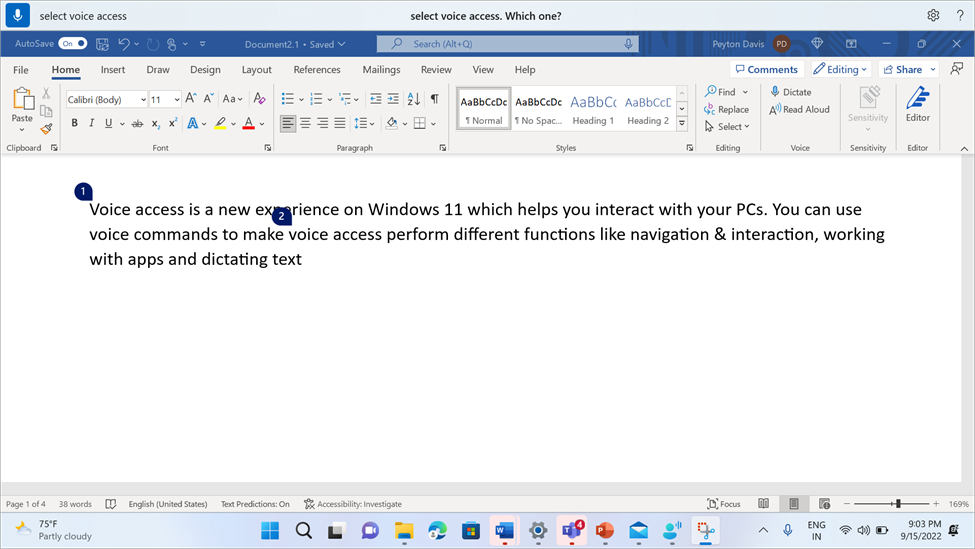This article is for people who want to control their PC and author text using their voice with Windows. This article is part of the Accessibility support for Windows content set where you can find more information on Windows accessibility features. For general help, visit Microsoft Support home.
When using voice access to dictate text and author documents, you can use voice commands to select text and edit the selected text. You can select the text that you dictated last, a specific piece of text, or select multiple characters, words, lines, or paragraphs. For a list of voice access commands, go to Voice access command list.
Voice access is a feature in Windows 11 that enables everyone to control their PC and author text using only their voice and without an internet connection. For example, you can open and switch between apps, browse the web, and read and author email using your voice. For more information, go to Use voice access to control your PC & author text with your voice.
Voice access is available in Windows 11, version 22H2 and later. For more information on Windows 11 22H2 new features, and how to get the update, see What's new in recent Windows updates. Not sure which version of Windows you have? See: Find Windows version.
If you want to select and edit the text you just dictated, say "Select that."
To select specific portions of the text you've dictated earlier, say "Select previous" or "Select next," followed by the number of words, characters, lines, or paragraphs you want to select. The text is selected relative to your current cursor position.
For example, if the cursor is at the beginning of the word "interact" and you say "Select previous two words," the words "helps you" are selected.
To select any phrase in a text box, regardless of the cursor position, say "Select," followed by the phrase. For example, to select the phrase "voice access," say "Select voice access." If there is more than one occurrence of the phrase "voice access," voice access places a numbered label on all occurrences and asks you to select the instance you want. Then say "Click," followed by the number associated with the instance of the phrase you want to select. For example, "Click one" selects the first occurrence of voice access on the first line.
You can also select a range of text in a text box. To do so, say “Select from,” followed by the starting text in the range, and then “To,” followed by the ending text of the range. For example, “Select from commands to functions” selects everything between the two words.
|
To do this |
Say this |
Example |
|---|---|---|
|
Select the last text you dictated. |
"Select that" |
|
|
Select all text in a text box. |
"Select all" |
|
|
Select a specific piece of text in a text box. |
"Select <text>" |
"Select hello world" |
|
Select a range of text in a text box. |
"Select from <text 1> to <text 2>" |
"Select from commands to functions" |
|
Select previous or next word(s). |
"Select previous <number of words>" or "Select next <number of words>" |
"Select previous word" or "Select next two words" |
|
Select previous or next character(s). |
"Select previous <number of characters>" or "Select next <number of characters>" |
"Select previous character" or "Select next three characters" |
|
Select previous or next line(s). |
"Select previous <number of lines>" or "Select next <number of lines>" |
"Select previous two lines" or "Select next four lines" |
|
Select previous or next paragraph(s). |
"Select previous <number of paragraphs>" or "Select next <number of paragraphs>" |
"Select previous two paragraphs" or "Select next three paragraphs" |
|
Clear the selected text. |
"Unselect that" |
To select non-editable text, use the grid overlay drag functionality. To select images and other non-text content, use the grid overlay. For more info, refer to Use the mouse with voice.
Note: If one of the selection commands throws an error, you can use other types of selection or the grid overlays.
See also
Technical support for customers with disabilities
Microsoft wants to provide the best possible experience for all our customers. If you have a disability or questions related to accessibility, please contact the Microsoft Disability Answer Desk for technical assistance. The Disability Answer Desk support team is trained in using many popular assistive technologies and can offer assistance in English, Spanish, French, and American Sign Language. Please go to the Microsoft Disability Answer Desk site to find out the contact details for your region.
If you are a government, commercial, or enterprise user, please contact the enterprise Disability Answer Desk.














